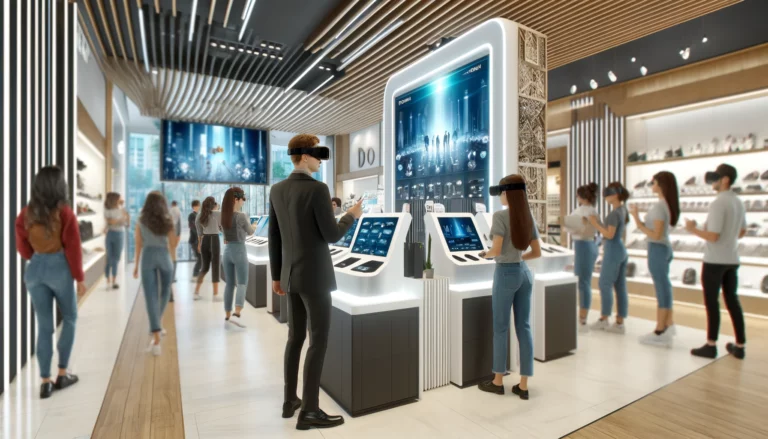Omnichannel Retail Solutions
Challenges in Omnichannel Retailing
Retailers are navigating a labyrinth of challenges as they strive to forge a seamless omnichannel experience. One towering hurdle is the integration of disparate systems, which often creates a disjointed customer journey that feels more like a patchwork quilt than a smooth tapestry. When inventory management, customer engagement platforms, and sales channels operate in their own isolated bubbles, it breeds inconsistent messaging—like whispers in different rooms—and stifles the delivery of personalized services that today’s consumers crave.
And let’s not forget about those legacy systems! They often resemble stubborn relics from another era, lacking the nimbleness needed to pivot toward new technologies or adapt to shifting consumer preferences. This adds yet another layer of complexity to an already intricate omnichannel strategy.
Then there’s the thorny issue of data management and analytics—a massive beast retailers must tame. The task involves sifting through oceans of customer data collected from countless touchpoints. This overwhelming influx can obscure actionable insights essential for informed decision-making. Plus, managing customer expectations across various interactions only complicates matters further; customers now anticipate nothing less than a harmonious experience, and any hiccup along the way can spark frustration and create an unsettling disconnect with the brand itself.
Tackling these multifaceted challenges isn’t just important; it’s imperative for retailers aiming to elevate customer satisfaction while enhancing overall performance in this fiercely competitive landscape.
Common Obstacles and Solutions
Retailers often find themselves grappling with a myriad of hurdles when it comes to weaving together omnichannel strategies. The fragmentation of customer data stands out as a formidable challenge—without that elusive, unified view of interactions sprawling across various channels, the quest for delivering truly personalized experiences becomes an uphill battle. And let’s not forget inventory visibility; many retailers stumble here too, resulting in lost sales opportunities and customers who leave feeling less than satisfied. Add into this mix the scarcity of resources and expertise in technology, and you’ve got a perfect storm that complicates the transition to effective omnichannel solutions.
To navigate these tumultuous waters, retailers can embrace several strategic maneuvers. First off, rolling out robust customer relationship management (CRM) systems can be a game changer for seamless data integration. This kind of technology opens up avenues for deeper insights into customer behaviors and preferences—an essential ingredient for enhancing personalization efforts. Moreover, pouring resources into advanced inventory management systems grants real-time visibility across all channels—a crucial edge in today’s fast-paced market landscape. Lastly, investing time in employee training while forging third-party partnerships could very well bridge those nagging technology gaps, ensuring that the leap into omnichannel operations isn’t just smooth but also sustainable.
Case Studies of Successful Omnichannel Retailers
Companies like Nike and Sephora have leaped into the world of omnichannel retailing, and oh, what a spectacle it is! Take Nike, for instance—a masterclass in blending mobile apps with online shopping and those familiar brick-and-mortar spaces. Their digital ecosystem isn’t just about selling shoes; it’s a symphony of customer experience! The Nike app—oh, how it dazzles! Users can snag products, schedule in-store visits at their leisure, and dive into exclusive offers that feel almost like secret treasures waiting to be unearthed. This clever strategy doesn’t merely inflate online sales figures; it also drives eager shoppers right through the doors of physical stores, weaving together every possible interaction point into one seamless tapestry.
And then there’s Sephora—a champion in harnessing the power of an omnichannel approach! With its stunning Virtual Artist feature, customers can playfully try on makeup as if they were standing before a mirror without so much as swiping a brush. This groundbreaking innovation transforms the mundane act of shopping into an exhilarating adventure while instilling confidence among buyers. But wait—there’s more! Sephora’s loyalty program shines brightly across both digital realms and store aisles alike—it’s all about engaging customers in ways that keep them coming back for more. Through these tech-savvy initiatives, Sephora crafts an intricate web connecting online delights with real-world charm—setting standards that others can only aspire to reach.
Lessons from Industry Leaders
Industry trailblazers in omnichannel retailing have masterfully showcased just how vital it is to weave together customer data across every conceivable platform. By tapping into sophisticated analytics, these powerhouses glean a rich tapestry of insights into consumer behavior—an intricate dance of preferences and patterns. This seamless integration doesn’t just stop at numbers; it empowers them to tailor marketing efforts with precision, elevating the customer experience into something truly remarkable—a fluid journey that flows effortlessly from online realms to brick-and-mortar realities.
But wait! There’s more! Another pivotal lesson from these retail giants highlights the sheer necessity of nurturing a cohesive company culture where customer satisfaction reigns supreme. Organizations that empower their employees to seize ownership over the customer experience consistently eclipse their rivals. Imagine training programs meticulously crafted around omnichannel strategies, equipping staff with the skills needed to deliver unwavering service no matter which channel customers choose. This harmonious approach fosters an environment bursting with enthusiasm and motivation among employees eager to meet—and exceed—customer expectations, ultimately translating into stellar business results!
Measuring Success in Omnichannel Retail
To truly grasp the effectiveness of omnichannel retail strategies, one must embark on a journey that weaves together a tapestry of diverse metrics. Picture this: Key Performance Indicators (KPIs)—those critical benchmarks like customer acquisition costs, retention rates, average order value, and conversion rates—acting as the compass guiding retailers through uncharted territory. But wait! There’s more to it than just numbers; delving into channel-specific performance reveals how each platform dances in harmony to drive overall sales and elevate customer engagement.
Now, let’s not forget about the magic of data analytics—a beacon illuminating pathways for improvement that businesses might overlook otherwise. Armed with concrete insights, they can refine their methods with precision! Amidst this complex landscape lies another layer: customer satisfaction metrics like Net Promoter Score (NPS) and feedback surveys form an essential part of the puzzle when evaluating the omnichannel experience.
Ah, but here’s where it gets really interesting: measuring how effortlessly customers flit from one channel to another is crucial—it can make or break loyalty and influence their likelihood to return for more! And don’t shy away from tracking inventory turnover rates alongside fulfillment accuracy; these elements inform operational efficiency in ways that can transform strategy into action.
All these insights intertwine not only to steer strategic decision-making but also cultivate a deeply customer-centric philosophy—one that elevates the shopping experience across every conceivable channel. It’s a riveting mix of analysis and adaptation in today’s ever-evolving retail landscape!
Key Performance Indicators (KPIs)
In the intricate world of omnichannel retail, deciphering success isn’t just a straightforward task; it demands an elaborate tapestry of key performance indicators—those essential KPIs that illuminate the labyrinthine paths of customer behavior across a myriad of channels. Consider metrics like customer lifetime value (CLV), conversion rates, and return on investment (ROI)—each one a critical beacon shedding light on the efficacy of a retailer’s omnichannel approach. But wait! There’s more to this story: tracking customer engagement and satisfaction scores can unearth hidden gems revealing strengths and weaknesses in the shopping experience, showcasing both triumphs and pitfalls.
And let’s not overlook inventory management efficiency—a KPI that retailers must scrutinize with keen eyes. A finely-tuned inventory system doesn’t merely enhance product availability; it dances delicately between minimizing overselling while sidestepping stockouts altogether. Moreover, delving into order fulfillment times and accuracy serves as another window into operational prowess. By establishing robust benchmarks for these multifaceted indicators, businesses can embark on an ongoing journey of performance assessment—adapting their strategies dynamically in response to ever-evolving customer expectations and the shifting sands of market trends.
Future Trends in Omnichannel Retail Solutions
The retail landscape of tomorrow is a thrilling maze, intricately woven with the threads of technological evolution and shifting consumer habits. Picture this: artificial intelligence and machine learning stepping into the spotlight, set to revolutionize personalization and predictive analytics in ways we’re only beginning to fathom. Retailers stand on the brink of offering hyper-tailored experiences that dance across various channels, reshaping customer satisfaction while simultaneously cranking up operational efficiency through automated inventory management and streamlined supply chains.
But wait—there’s more! The fusion of augmented reality (AR) and virtual reality (VR) into our shopping escapades is gaining momentum like an unstoppable wave. Imagine customers diving headfirst into immersive product interactions that blur the lines between online browsing and brick-and-mortar exploring. As retailers delve deeper into these captivating technologies, they unlock a treasure trove of compelling experiences designed not just for engagement but for fostering unwavering customer loyalty—and yes, boosting those sales figures too.
Yet, embarking on this journey demands meticulous strategizing and investment—a leap forward fraught with challenges but teeming with potential rewards for those audacious enough to embrace change. The future isn’t just approaching; it’s bursting onto the scene in technicolor splendor!
Innovations to Watch
The surge of artificial intelligence is dramatically transforming the landscape of omnichannel retail, crafting personalized shopping journeys like never before. Retailers are diving headfirst into AI-driven analytics, uncovering a treasure trove of insights about customer tastes and behaviors that were once obscured in data fog. With enhanced data processing capabilities at their fingertips, marketers can launch laser-focused campaigns, ensuring consumers encounter finely tailored recommendations no matter where they shop.
But wait—there’s more! Enter augmented reality (AR), another dazzling innovation captivating the retail realm. This tech wizardry empowers customers to visualize products within their own spaces prior to hitting that buy button. Picture this: furniture retailers deploying AR apps that let shoppers see exactly how a new couch would fit snugly in their living room corner. Such immersive experiences not only heighten engagement levels but also slash return rates dramatically; after all, when consumers can envision their purchase with clarity, confidence follows suit!
| Innovation | Description | Benefits |
|---|---|---|
| AI-driven Analytics | Utilizes machine learning algorithms to analyze customer data and behaviors. | Provides personalized recommendations, enhances customer engagement, and improves marketing efficiency. |
| Augmented Reality (AR) | Enables customers to visualize products in their own environment before purchase. | Increases customer confidence, reduces return rates, and enhances overall shopping experience. |
| Chatbots | Automated customer service agents that provide 24/7 support. | Improves response time, enhances customer satisfaction, and reduces operational costs. |
| Virtual Try-Ons | Allows customers to try products such as clothing or makeup virtually. | Boosts conversion rates and minimizes the need for returns. |
Choosing the Right Omnichannel Solution Provider
Choosing the right provider for omnichannel solutions is absolutely vital for companies striving to cultivate a smooth and cohesive customer experience. It’s not just about picking any old partner; businesses must dive deep into the provider’s expertise across various retail formats, scrutinizing their knack for weaving together multiple sales channels seamlessly. A keen grasp of the particular demands within an industry can dramatically enhance how effective those solutions turn out to be.
It’s imperative that potential partners flaunt a proven history of successful deployments in similar business environments. Don’t overlook the importance of evaluating customer support, ongoing maintenance options, and how well these solutions can scale over time—this is crucial if you want to ensure long-term triumph. Moreover, organizations should actively seek out providers that offer customizable features—after all, as market trends shift and consumer preferences morph like quicksilver, flexibility becomes key!
Criteria for Selection
Choosing the right omnichannel solution provider isn’t just a task—it’s an intricate dance of deliberation and strategy. Organizations must dive deep into evaluating how well a potential partner can blend seamlessly with their existing systems and platforms, like pieces in a jigsaw puzzle that fit together effortlessly. But it doesn’t stop there; the breadth of support services on offer is equally crucial. Retail teams thrive when they have access to comprehensive training and ongoing assistance, so companies should seek out partners who are committed to nurturing this vital aspect.
Yet another pivotal factor is the provider’s history—a tapestry woven from their track record and standing in the industry. Delving into case studies and testimonials can illuminate how these solutions perform under real-world pressures, revealing insights that numbers alone might obscure. Flexibility? Absolutely essential! The ability for technology to scale up or pivot swiftly is paramount as retail landscapes shift like sands in an hourglass. And let’s not overlook data security—it looms large in today’s decision-making arena, especially with mounting anxieties surrounding consumer privacy swirling about us like fog on a chilly morning. Prioritizing providers who demonstrate not only awareness but also robust compliance measures will be key as organizations navigate this complex landscape.
- Evaluate the compatibility of the omnichannel solution with existing systems.
- Consider the range and quality of support services provided.
- Review case studies and testimonials to assess the provider’s track record.
- Ensure the technology can scale and adapt to changing market conditions.
- Prioritize data security and compliance with industry regulations.
- Investigate the provider’s commitment to ongoing training and assistance for retail teams.
- Analyze the flexibility of the solution to meet diverse business needs.
Conclusion
The transformation of retail into an omnichannel paradigm is fundamentally altering the dynamics of customer interaction. Brands, in their quest for innovation, are weaving together experiences that flow seamlessly across a myriad of touchpoints—this not only boosts customer satisfaction but also cultivates unwavering loyalty. For retailers striving to provide tailored service while juggling operational intricacies, embracing technology becomes not just important but imperative.
As we gaze into the future, companies must be agile and attuned to the shifting tides of trends and consumer preferences. Crafting robust omnichannel strategies will do more than merely propel sales; it will enable retailers to adeptly maneuver through a fiercely competitive arena. By investing in cutting-edge tools and insightful analytics, businesses can gauge their success with precision and perpetually refine the customer journey for optimal engagement and satisfaction.





